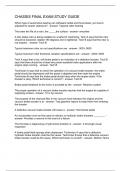Rania El Ghalbzouri
IBT-B
Procurement & Supply chain Summary
Chapter 1: Supply Chain & Introduction
Supply Chain Circle: A circular supply chain involves a company reusing or repurposing waste
and customer returns to convert those into new or refurbished products. A circular supply chain
aims to minimize the use of raw materials and minimize discarded waste materials.
1. History of Supply Chain Management
The Egyptians:
The Egyptians skillfully managed their supply chain while constructing the pyramids. They
transported various supplies, such as large limestone blocks, food, people, mules, and
equipment, by utilizing the Nile River and a channel leading to the port of Gizeh. This example
underscores the significance of efficient transportation and logistics in managing a
multifaceted supply chain, which remains a fundamental tenet of contemporary SCM.
The Romans:
The logistical practices of the ancient Romans during Caesar's conquest of Gaul: Caesar led 5
legions and a supply group of 500-550 mules and guides, while soldiers carried their own
equipment and rations. The Romans were the first to establish logistics as a separate division
and built a network of semi-paved roads for easy transportation of legions and supplies,
optimizing communication between regions. These roads were well-protected and patrolled,
highlighting the importance of security in managing an efficient supply chain, a principle that
is still relevant in contemporary SCM.
Napoleon Bonaparte:
Napoleon Bonaparte was a pioneer of modern military logistics and a key figure in the
development of modern-day SCM. He introduced innovative systems to streamline supply
chain operations, including depots, supply centers, and specialized personnel. Additionally, he
implemented standardization of equipment, provisions, and transportation, and utilized
communication technology for supply chain management. These principles continue to form
the foundation of contemporary SCM, making Napoleon's contributions to logistics significant
and long-lasting.
1
, Rania El Ghalbzouri
IBT-B
World War II:
Logistics played a vital role in determining the outcome of World War II. Effective supply chain
operations gave military forces a significant advantage on the battlefield, as demonstrated in
key battles and operations such as D-Day and the Battle of Stalingrad. The Allies' efficient
logistics system ultimately contributed to their victory, while the Axis powers' logistical
weaknesses, such as Germany's inability to maintain supply lines, led to their defeat.
Recent History:
2. Transport & Logistics & Supply Chain Management
3. Definitions SCM vs Logistics
Definition SCM:
Supply Chain Management contains the planning and management of all activities involved
in sourcing and procurement, conversion, and all logistics management activities. Importantly,
it also includes coordination and collaboration with the internal/external partners, which can
be suppliers, third-party service providers and customers. In essence, supply chain
management integrates supply and demand management within and across companies.
Definition Logistics:
Logistics management is the part of supply chain management that plans, implements, and
controls the efficient, effective forward and reverse flow, storage of goods, services, and
related information between point of origin and point of consumption to meet customer's
requirements.
2
, Rania El Ghalbzouri
IBT-B
1. Transport Modi: Road Transport
Road transport is a common mode of transportation for goods, and there are different options
available depending on the volume and destination of the shipment.
For full truck loads (FTL), everything is positioned into the truck, and a standard pallet size of
0.8x1.2m is used. This type of transport can accommodate around 32-33 pallets in a truck that
measures 13.5x2.45m.
On the other hand, for partial loads (LTL), shipping less than 33 pallets allows the customer to
pay only for the used space on the truck, and the remaining space can be booked by another
customer.
For a trucking company, relevant information for LTL shipments would include the quantity of
pallets/boxes/units, the final destination, weight, origin, and any instructions such as loading
time. Additionally, it is important to have information on the goods or products being
transported to ensure they are handled and transported appropriately.
Effective communication of these details can help ensure smooth and efficient transport of
goods for both the company and their customers.
Stakeholders1 – Stakeholders Road Transport
• Manufacturer (Shipper)
• Freight Forwarder (FF)
• Trucking Company
• Customs
• Warehouse (WHS)
• Distribution Centre (DC)
• Logistics Service Providers (LSP’s)
• Customer
2 – Stakeholders Air Freight
• Manufacturer (Shipper)
• Freight Forwarder (FF)
• Trucking Company
• Airlines
• Ground handler (GHA)
• Tarmac Transport
• Customs
• Local agent
• Warehouse (WHS)
• Logistics Service Providers (LSP’s)
• Customer
3
, Rania El Ghalbzouri
IBT-B
3 – Stakeholders Sea Freight
• Manufacturer (Shipper) (1)
• Freight Forwarder (FF) (2)
• Trucking Company/Rail Operator
• Distribution Centre
• Terminal Handling
• Carrier
• Customs
• Local agent
• Warehouse (WHS)
• Logistics Service Providers (LSP’s)
• Customer (8)
Other Transport Modi
• Rail Transport
• Multi modal transport
• Intermodal transport
• Air/Sea
• Pipelines
• Barge
• Drones ...
4. Example of SCM Process Flow and Case Study
4





